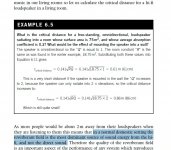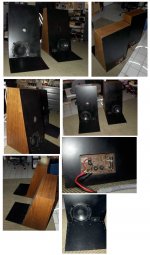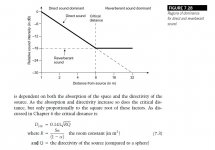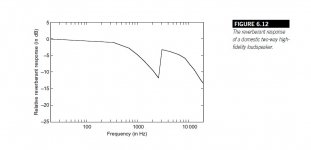Hello George,
I hope you have time enough for this monster thread.
http://www.diyaudio.com/forums/planars-exotics/133711-piezo-nxt-type-panel.html
Oliver
I hope you have time enough for this monster thread.
http://www.diyaudio.com/forums/planars-exotics/133711-piezo-nxt-type-panel.html
Oliver
Layered Sound
Hi,
thanks for that reference.... it is huge... I jut started to read it but realised that I need more time.
However, I thought I should check that what I wrote about Shelley Katz's speakers was accurate so I sent him a copy. I then received an invite to visit him at his laboratory and he has also offered to send/lend me some of his speakers to use at home!
I am very keen to take up this offer, but it will nto be until mid/late August when we are back from holiday.
I have a choice of speakers to use with his.. Quad ESL57, Yamaha NS1000M, or JBL4343... I am not sure which to use at the moment. Any thoughts on this or the evaluation..... which I would write up for this and the other forum that you mentioned.?
George
Hi,
thanks for that reference.... it is huge... I jut started to read it but realised that I need more time.
However, I thought I should check that what I wrote about Shelley Katz's speakers was accurate so I sent him a copy. I then received an invite to visit him at his laboratory and he has also offered to send/lend me some of his speakers to use at home!
I am very keen to take up this offer, but it will nto be until mid/late August when we are back from holiday.
I have a choice of speakers to use with his.. Quad ESL57, Yamaha NS1000M, or JBL4343... I am not sure which to use at the moment. Any thoughts on this or the evaluation..... which I would write up for this and the other forum that you mentioned.?
George
Layered Sound
Hi,
this is kind of experiment that I am interested in. Personally I am nervous about giving up the precision of the sounds that I get from the Quads and Yamahas, but supplementing them with DML speakers may be the way to go.
If I am right that many recording techniques remove/ignore ambiance in favour of precision then adding some back (even if not the original, if it existed) is OK.
I am wondering what happens when the recording technique seeks to capture teh ambience and DML speakers are used as supplements to the beamy main speakers. Ambience on ambience?
George
Hi,
this is kind of experiment that I am interested in. Personally I am nervous about giving up the precision of the sounds that I get from the Quads and Yamahas, but supplementing them with DML speakers may be the way to go.
If I am right that many recording techniques remove/ignore ambiance in favour of precision then adding some back (even if not the original, if it existed) is OK.
I am wondering what happens when the recording technique seeks to capture teh ambience and DML speakers are used as supplements to the beamy main speakers. Ambience on ambience?
George
His solution is to combine traditional high quality speakers producing so-called coherent sound, together with his transverse wave panel speakers. These speakers (see Podium) are excited by a set of drivers so as to add the resonances (incoherent sounds) which are typical in a live environment but which are generally lost in the close-miking recording process.
[...]
This is an interesting proposal and might account for the popularity of some older speakers which bring their resonances and "character" into play and which at the same time enhance the listening experience.
While I find the considerations to be admirable, double-blind testing indicates people dislike speakers with resonances, since they introduce a colouration of their own. They accentuate certain aspects which are different from the original instruments.
However, adding repetition does indeed enhance the timbral character of recorded sounds. The correct solution would then be to better record music and include the reflections in the recording venue, which contain information about the resonances and dispersion patterns of the instruments. Have you ever seen the dispersion pattern of a violin at different frequencies?
Multichannel recordings are an excellent medium for this but are not really catching on unfortunately. Even stereo recordings are often not what they could be.
Layered Sound
Hi,
I agree with your points in your comment above.
During his presentation Shelley actually talked about having, as an extreme example, one DML per instrument being reproduced. Thus there would be piano, violin, cello and so on speakers aimed at producing the typical resonances of each instrument.
It does seem that we are trying to cure problems introduced at the recording end of the process by fixing the end of the playback process. Assuming that we cannot fix the recording side it is probably still worthwhile to try this, especially as the costs to experiment in this area appear to be quite low.
I would be concerned if the resonances from the DML speaker became the overriding impression of the sound. It does need some control perhaps frequency or instrument dependent. The latter could be achieved, at a cost, by one speaker per instrument. The former could be achieved by common electrical methods.
Hi,
I agree with your points in your comment above.
During his presentation Shelley actually talked about having, as an extreme example, one DML per instrument being reproduced. Thus there would be piano, violin, cello and so on speakers aimed at producing the typical resonances of each instrument.
It does seem that we are trying to cure problems introduced at the recording end of the process by fixing the end of the playback process. Assuming that we cannot fix the recording side it is probably still worthwhile to try this, especially as the costs to experiment in this area appear to be quite low.
I would be concerned if the resonances from the DML speaker became the overriding impression of the sound. It does need some control perhaps frequency or instrument dependent. The latter could be achieved, at a cost, by one speaker per instrument. The former could be achieved by common electrical methods.
I think the hole in the middle is just the typical loss of the center image when path lengths aren't exact. There is also the question of how much well centered material the recording contains. Classical music with spaced mics might be weak in this area. There are a lot of early pop stereo recordings that use left center and right as the only image locations. They would make a good test (I'm listening to a "Best of Marvin Gaye" these days, which would suit.)
Klipsch was mostly following the recommendations from the Bell Labs experiments that he liked well enough to reprint and distribute. If you must put your speakers in opposite corners then adding a center can be helpful. Note that for a period of time he was advocating a center channel connection that used out-of-phase difference information, until that error was pointed out to him. Even the greats make mistakes.
David S.
Klipsch was an advocate of a Center Ch speaker to go with the Cornerhorns. Back in the sixties and seventies there were a number of preamps that had mono center ch outputs.
The latter could be achieved, at a cost, by one speaker per instrument.
limits your instrument count, and you would need a high degree of seperation between the instruments when recording, which implies highly directional mics, which dont record a very realistic sound.
Last edited:
The Podium speaker looks interesting
PodiumSound : Modèle .5
thanks for the tip-off.
I've not a great deal to contribute to this thread but on the subject of centre speakers, imaging and the room, Ted Jordan did some experiments in the 1970s with a centre speaker. It later led to the Stereola enclosure, a central speaker which used reflectors in the usual place of left and right speakers.
The article is a PDF download on his site - it's the one entitled
Loudspeaker stereo techniques Wireless World, February 1971
E.J.Jordan Designs - book & articles design & consultancy
I tried a basic version of it years ago and it seemed to work quite well. Two speakers back to back in the centre and a couple of formica-topped coffee tables as reflectors. (not exactly high tech).
PodiumSound : Modèle .5
thanks for the tip-off.
I've not a great deal to contribute to this thread but on the subject of centre speakers, imaging and the room, Ted Jordan did some experiments in the 1970s with a centre speaker. It later led to the Stereola enclosure, a central speaker which used reflectors in the usual place of left and right speakers.
The article is a PDF download on his site - it's the one entitled
Loudspeaker stereo techniques Wireless World, February 1971
E.J.Jordan Designs - book & articles design & consultancy
I tried a basic version of it years ago and it seemed to work quite well. Two speakers back to back in the centre and a couple of formica-topped coffee tables as reflectors. (not exactly high tech).
Hi,
thanks for reminding me about Jordan. I do have his book buried somewhere, but it is nice to know that he is still in business.
I seem to recall that at the end of his book he discusses a "shelf" of loudspeakers running around or across a room, with many units (his presumably) fed from the left and right channels but with a delay line to stagger the sound. Now that would give a broad sound stage, if the original recording had captured it. I don't know if this ever went into production and I have not heard of it outside of his book
George
thanks for reminding me about Jordan. I do have his book buried somewhere, but it is nice to know that he is still in business.
I seem to recall that at the end of his book he discusses a "shelf" of loudspeakers running around or across a room, with many units (his presumably) fed from the left and right channels but with a delay line to stagger the sound. Now that would give a broad sound stage, if the original recording had captured it. I don't know if this ever went into production and I have not heard of it outside of his book
George
Hi Graaf,
the ratio of reflected / direct sound and the quality of the reflected sound are very important aspects.
You might be interested in what I have assembled (in writing) about these aspects and some additional ones.
It is a bit lengthy, so again my recommnedation to enjoy it with your favorite beverage/beveridge
What is the optimum polar response of a speaker
the ratio of reflected / direct sound and the quality of the reflected sound are very important aspects.
You might be interested in what I have assembled (in writing) about these aspects and some additional ones.
It is a bit lengthy, so again my recommnedation to enjoy it with your favorite beverage/beveridge
What is the optimum polar response of a speaker
thanks!
I believe this one belongs in this thread:
http://www.diyaudio.com/forums/multi-way/136887-snell-type-1s.html
Stig Carlsson referred to this design in His patent application
I believe this one belongs in this thread:
One of Peter Snell's earliest design, the 'type 1' had the tweeter at the very bottome of the cabinet that included a bottom 'flap' to reflect the tweeter's output. However, that was the end of that approach. Peter later went on to create the Model "A" and the rest is history.
http://www.diyaudio.com/forums/multi-way/136887-snell-type-1s.html
Stig Carlsson referred to this design in His patent application
Last edited:
The model A preceeded the type 1. At Snell we referred to the type 1 (affectionately) as "the wheelchair ramp". (It had a shallow ramp leading up to the mid point of the tweeter.)
Not a big seller.
Note that in my testing the critical distance in a typical listening room is about equal to the listening distance. That is, you here direct field and reverberent field in roughly equal proportions. No matter what, your ear/brain is pretty good at hearing through to the direct/early sound.
Be careful when giving credance to RTA curves over direct field measurements.
David
Not a big seller.
Note that in my testing the critical distance in a typical listening room is about equal to the listening distance. That is, you here direct field and reverberent field in roughly equal proportions. No matter what, your ear/brain is pretty good at hearing through to the direct/early sound.
Be careful when giving credance to RTA curves over direct field measurements.
David
Note that in my testing the critical distance in a typical listening room is about equal to the listening distance. That is, you here direct field and reverberent field in roughly equal proportions. No matter what, your ear/brain is pretty good at hearing through to the direct/early sound.
so 2-3 meters? in a typical listening room? are You sure? which frequency band? what is the directivity of loudspeakers used for those test?
Last edited:
- Home
- Loudspeakers
- Multi-Way
- The Advantages of Floor Coupled Up-Firing Speakers



